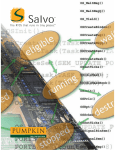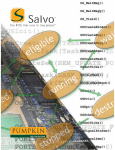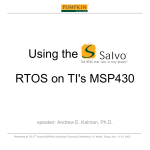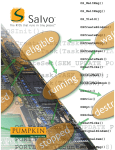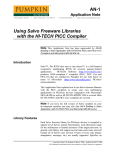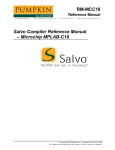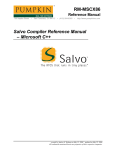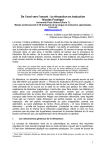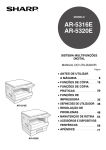Download RM-HTARCLITE Salvo Compiler Reference Manual
Transcript
RM-HTARCLITE
Reference Manual
750 Naples Street
•
San Francisco, CA 94112
• (415) 584-6360
•
http://www.pumpkininc.com
Salvo Compiler Reference Manual
– HI-TECH ARClite-C
created by Andrew E. Kalman on Feb 23, 2004 updated on Feb 23, 2004
All trademarks mentioned herein are properties of their respective companies.
Reference Manual
Introduction
This manual is intended for Salvo users who are targeting ARC
International's
(http://www.arc.com)
ARClite
microRISC
synthesizable 8-bit RISC core general-purpose microprocessor
with HI-TECH Software's (http://www.htsoft.com/) ARClite-C
compiler.
Note The ARClite microRISC was originally developed and
marketed by VAutomation as the V8 µ-RISC 8-bit synthesizable
core. At the time that Salvo was ported to this processor, the HITECH compiler1 was called V8C, and HI-TECH's IDE for the V8
was called HPDV8. Currently, the naming convention used within
the Salvo for ARClite microRISC distribution contains references
to ARClite and V8.
Related Documents
The following Salvo documents should be used in conjunction
with this manual when building Salvo applications with HITECH's ARClite-C C compiler:
Salvo User Manual
Application Note AN-30
Example Projects
Example Salvo projects for use with HI-TECH's ARClite-C C
compiler and the HI-TIDE HPDV8 IDE can be found in the:
\salvo\tut\tu1\sysl
\salvo\tut\tu2\sysl
\salvo\tut\tu3\sysl
\salvo\tut\tu4\sysl
\salvo\tut\tu5\sysl
\salvo\tut\tu6\sysl
directories of every Salvo for ARClite microRISC distribution.
Features
Table 1 illustrates important features of Salvo's port to HI-TECH's
ARClite-C C compiler.
2
RM-HTARCLITE Salvo Compiler Reference Manual – HI-TECH ARClite-C
Reference Manual
general
Salvo Lite, LE & Pro
for ARClite microRISC
ARClite microRISC core
portv8c.h
portv8c.as
SYSL
available distributions
supported targets
header file(s)
other target-specific file(s)
project subdirectory name(s)
salvocfg.h
compiler auto-detected?
yes
2
libraries
salvo\lib subdirectory
htv8c
context switching
function-based via
OSDispatch() & OSCtxSw()
yes
total size must not exceed 255 8-bit
bytes
method
_OSLabel() required?
size of auto variables and
function parameters in tasks
interrupts
3
I bit (PSR[3])
critical sections, OSDisptach()
and OSCtxSw()
controlled via
disabled in
interrupt status preserved in
critical sections?
no
interrupts disabled on entry and
enabled on exit of critical sections
no nesting permitted
4
yes
method used
nesting limit
alternate methods possible?
debugging
source-level debugging with Pro
library builds?
yes
compiler
bitfield packing support?
printf() / %p support?
va_arg() support?
no
yes / yes
yes
Table 1: Features of Salvo Port to HI-TECH's ARClite-C
C Compiler
Libraries
Nomenclature
The Salvo libraries for HI-TECH's ARClite-C C compiler follow
the naming convention shown in Figure 1.
RM-HTARCLITE Salvo Compiler Reference Manual – HI-TECH ARClite-C
3
Reference Manual
sfcv8ab.lib
Salvo library
type
f: freeware
l: standard
ARClite-C
variant
a: fns called from anywhere
b: fns called from background only
f: fns called from foreground only
-: not applicable
configuration
a: multitasking with delays and events
d: multitasking with delays
e: multitasking with events
m: multitasking only
t: multitasking with delays and events,
tasks can wait with timeouts
target
ARClite microRISC
(formerly V8 µ-RISC)
Figure 1: Salvo Library Nomenclature – HI-TECH's
ARClite-C C Compiler
Type
Salvo Lite distributions contain freeware libraries. All other Salvo
distributions contain standard libraries. See the Libraries chapter of
the Salvo User Manual for more information on library types.
Target
No target-specific identifiers are required.
Configuration
Different library configurations are provided for different Salvo
distributions and to enable the user to minimize the Salvo kernel's
footprint. See the Libraries chapter of the Salvo User Manual for
more information on library configurations.
Variant
When using HI-TECH's ARClite-C C compiler, the Salvo source
code must be properly configured via the appropriate configuration
parameters. The Salvo libraries for HI-TECH's ARClite-C C
compiler are provided in different variants as shown in Table 2.
If your application does not call any Salvo services from within
interrupts, use the b variant. If you wish to these services
exclusively from within interrupts, use the f variant. If you wish to
do this from both inside and outside of interrupts, use the a variant.
In each case, you must call the services that you use from the
4
RM-HTARCLITE Salvo Compiler Reference Manual – HI-TECH ARClite-C
Reference Manual
correct place in your application, or either the linker will generate
an error or your application will fail during runtime.
variant code
description
Applicable services can be called
from anywhere, i.e. from the
foreground and the background,
simultaneously.
Applicable services may only be
called from the background (default).
Applicable services may only be
called from the foreground.
a / OSA:
b / OSB:
f / OSF:
Table 2: Variants for Salvo Libraries – HI-TECH's
ARClite-C C Compiler
See the OSCALL_OSXYZ configuration parameters for more
information on calling Salvo services from interrupts.
See Special Considerations, below, for more information on using
library variants.
Build Settings
Salvo's libraries for HI-TECH's ARClite-C C compiler are built
using the default settings outlined in the Libraries chapter of the
Salvo User Manual. Target-specific settings and overrides are
listed in Table 3.
compiled limits
max. number of tasks
max. number of events
max. number of event flags
max. number of message
queues
3
5
1
1
target-specific settings
delay sizes
watchdog timer
system tick counter
8 bits
not affected
available, 32 bits
Table 3: Build Settings and Overrides for Salvo Libraries
for HI-TECH's ARClite-C C Compiler
Note The compiled limits for tasks, events, etc. in Salvo libraries
can be overridden to be less (all Salvo distributions) or more (all
Salvo distributions except Salvo Lite) than the library default. See
the Libraries chapter of the Salvo User Manual for more
information.
RM-HTARCLITE Salvo Compiler Reference Manual – HI-TECH ARClite-C
5
Reference Manual
Available Libraries
There are 30 Salvo libraries for HI-TECH's ARClite-C C compiler.
Each Salvo for ARClite microRISC distribution contains the Salvo
libraries of the lesser distributions beneath it.
salvocfg.h Examples
Below are examples of salvocfg.h project configuration files for
various different Salvo distributions and the ARClite microRISC.
Note When overriding the default number of tasks, events, etc. in
a Salvo library build, OSTASKS and OSEVENTS (respectively) must
also be defined in the project's salvocfg.h. If left undefined, the
default values (see Table 3) will be used.
Salvo Lite Library Build
#define
#define
#define
#define
OSUSE_LIBRARY
OSLIBRARY_TYPE
OSLIBRARY_CONFIG
OSLIBRARY_VARIANT
TRUE
OSF
OSA
OSB
Listing 1: Example salvocfg.h for Library Build Using
sfcv8ab.lib
Salvo LE & Pro Library Build
#define OSUSE_LIBRARY
#define OSLIBRARY_CONFIG
#define OSLIBRARY_VARIANT
TRUE
OST
OSA
Listing 2: Example salvocfg.h for Library Build Using
slcv8ta.lib
Salvo Pro Source-Code Build
#define
#define
#define
#define
OSENABLE_IDLING_HOOK
OSENABLE_SEMAPHORES
OSEVENTS
OSTASKS
TRUE
TRUE
1
3
Listing 3: Example salvocfg.h for Source-Code Build
6
RM-HTARCLITE Salvo Compiler Reference Manual – HI-TECH ARClite-C
Reference Manual
Performance
Memory Usage
tutorial memory usage5
tu1lite
tu2lite
tu3lite
tu4lite
tu5lite
tu6lite
tu6pro
total ROM6
total RAM7
383
538
579
1183
1828
1994
1819
31
32
34
48
72
72
68
Table 4: ROM and RAM requirements for Salvo
Applications built with HI-TECH's ARClite-C C Compiler
Special Considerations
Stack Issues
For architectural reasons, HI-TECH's ARClite-C C compiler does
not pass parameters on the stack. Nor does it allocate memory for
auto (local) variables on the stack. Instead, it employs a static
overlay model. This has advantages in speed and memory
utilization, but it precludes recursion and has other impacts.
Multiple Callgraph Issues
By default, it is expected that Salvo services will only be called
from the background / main loop / task level. This is the default
configuration for source-code builds. b-variant libraries allow
service calls only from the background level. Should you wish to
call certain services from the foreground / interrupt level, you will
need to set OSCALL_OSXYZ configuration options for source-code
builds or use a different library (see Table 2) for library builds.
From Variant, above, we find that the f-variant libraries allow you
to call event-reading and –signaling services from the foreground.
Similarly, the a-variant libraries allow you to call the applicable
services from anywhere in your code.
RM-HTARCLITE Salvo Compiler Reference Manual – HI-TECH ARClite-C
7
Reference Manual
The interrupt_level Pragma
When using the a-variant libraries, each instance of an applicable
service in use must be called from the foreground, i.e. from an
interrupt. Also, ARClite-C's interrupt_level pragma must be set
to 0 and placed immediately ahead of the application's interrupt
routine, like this:
#pragma interrupt_level 08
void interrupt IntVector( void )
{
OSStartTask(TASK_P);
}
Listing 4: Setting the HI-TECH ARClite-C interrupt_level
Pragma for an ISR when Using a-variant Libraries
ARClite-C requires this in order to manage the parameter overlay
areas for functions located on multiple call graphs.
Note This pragma has no effect if there aren't any functions
located on multiple call graphs. Therefore it's OK to add it to any
application compiled with ARClite-C.
Example: Foreground Signaling of One Event Type
In a library build, if you were to move a call to OSSignalBinSem()
from a Salvo task (i.e. from the background) to an interrupt handler
(i.e. to the foreground) without changing the library variant, you'd
find that the application crashes from a stack overflow almost
immediately. This is because the default interrupt control9 in
OSSignalBinSem() is incompatible with being placed inside an
interrupt.
To
circumvent
this,
you
must
change
OSLIBRARY_VARIANT to OSF and link an f-variant library (e.g.
sfcv8af.lib — note the f for foreground in the variant field) in
order to properly support event service calls in the foreground.
Example: Foreground and Background Signaling of One Event
Type
If we call OSSignalBinSem() from a task and from within an
interrupt handler without addressing the callgraph issues, the
compiler issues an error message:
Error[ ] file : function _OSSignalBinSem appears
in multiple call graphs: rooted at intlevel0 and
_main Exit status = 1
8
RM-HTARCLITE Salvo Compiler Reference Manual – HI-TECH ARClite-C
Reference Manual
To resolve this, add the interrupt_level 0 pragma to your
interrupt handler (see Listing 4, above) and use the a-variant
library after setting OSLIBRARY_TYPE to OSA.
OSProtect() and OSUnprotect()
HI-TECH's ARClite-C C compiler requires that when a function is
contained in multiple callgraphs, interrupts must be disabled
"around" that function to prevent corruption of parameters and/or
return values.10 Therefore you must call OSProtect() immediately
before and OSUnprotect() immediately after all background
instances of every Salvo service that is called from both the
background and foreground levels, e.g.:
void TaskN ( void )
{
…
OSProtect();
OSSignalBinSem(SEM_P);
OSUnprotect();
…
}
#pragma interrupt_level 0
void interrupt IntVector( void )
{
OSSignalBinSem(SEM_P);
}
Tip Wrapping
OSProtect(),
the affected Salvo service and
OSUnprotect() within another function can make your code more
legible. The wrapper may only be called from mainline code – i.e.
it can only have a single callgraph. A wrapper function might look
like this:
OSSignalBinSem_Wrapper(OStypeEcbP ecbP)
{
OSProtect();
OSSignalBinSem(ecbP);
OSUnprotect();
}
and a wrapper macro might look like this:
#define OSSignalBinSem_Wrapper(ecbP) \
do { OSProtect(); \
OSSignalBinSem(ecbP); \
OSUnprotect(); \
} while (0)
RM-HTARCLITE Salvo Compiler Reference Manual – HI-TECH ARClite-C
9
Reference Manual
Example: Mixed Signaling of Multiple Event Types
The library variants affect all event services equally – that is, an fvariant library expects all applicable event services to be called
from the foreground, i.e. from within interrupts. If you wish to call
some services from the background, and others from the
foreground, you'll have to use the a-variant library, as explained
above.
A complication arises when you need an a-variant library for a
particular event type, and you also are using additional event types.
In this case, each instance of an applicable event service in use
must be called from the foreground. If it's not called from the
foreground, the compiler issue this error message:
Error[ ] file : function _OSSignalBinSem is not
called from specified interrupt level
Exit status = 1
However, it need not be called from the background. If you have
the "opposite" situation, e.g. you are using an a-variant library for
one type of event and you need to call an event service for a
different event type only from the background, one solution is to
place the required foreground call inside an interrupt handler, with
a conditional that prevents it from ever happening, e.g.:
#pragma interrupt_level 0
void interrupt IntVector( void )
{
/* real code is here …
*/
…
/* dummy to satisfy call graph. */
if ( 0 )
{
OSSignalBinSem(OSECBP(1));
}
}
This creates a call graph acceptable to HI-TECH's ARClite-C C
compiler and allows a successful compile and execution.
Interestingly, the optimizer will remove the call from the final
application.
Interrupt Control
In the original11 V8 core specification, bit 3 in the Processor Status
Register (PSR[3], the I bit) selects a second bank of registers
which are used only during interrupt processing. Additionally,
interrupts are enabled when I is cleared (0), and disabled when I
10
RM-HTARCLITE Salvo Compiler Reference Manual – HI-TECH ARClite-C
Reference Manual
is set (1). Normally, when an interrupt is acknowledged and I is
automatically set, the interrupt is processed with the alternate
register set, and then the normal register set is restored upon
returning from the interrupt. This implementation was designed to
improve interrupt performance.
Unfortunately, this scheme causes problems with any background /
task-level code that wishes to explicitly disable interrupts, e.g. for
a critical code section that accesses global variables. That's
because it changes the register set in use, which is at odds with the
compiler's register allocation and use.
Most ARClite microRISC users change the default implementation
to separate the register bank switching from the actions of the I bit.
In these implementations, register bank switching requires an
explicit action on the part of the programmer. The result is that
interrupts can be explicitly disabled without switching the register
bank:
"The only change made to the V8-microRISC CPU
core is that PSR[4] is used select the alternate bank of
registers instead of PSR[3] (I bit). Using a PSR[4] allows
software to decide when to select the alternate register
bank. Masking interrupts without switching register banks
allows software to perform atomic operations without
losing the contents of the registers. Interrupts can use the
alternate register bank by simply executing a STP 4 opcode
which is considerably faster than pushing all of the
registers. Also, upon the execution of the RTI opcode at the
end of the interrupt service routine, the PSR is reloaded
with the value from the stack. This automatically selects the
register bank that was in use before the interrupt was
taken. Note that it is up to the software to very carefully
manage which interrupts will use the alternate register
bank by setting PSR[4] and which interrupts will simply
push the required registers onto the stack. Note that
PSR[4] cannot be used for any other purpose." 12
In order to be compatible with the original VAutomation
Simulator, which implements register bank switching when the I
bit is changed, the default definitions for Salvo's interruptcontrolling macros OSDi() and OSEi() do not explicitly
manipulate the I bit. While appropriate for use in the simulator, it
is unlikely that these definitions will work for real target hardware.
RM-HTARCLITE Salvo Compiler Reference Manual – HI-TECH ARClite-C
11
Reference Manual
When targeting real hardware, Salvo Pro users should add the
following definitions to their salvocfg.h files and rebuild their
projects, and also use them when building custom libraries:
#define OSDi()
#define OSEi()
di()
ei()
where di() and ei() are defined by HI-TECH's ARClite-C C
compiler to disable and enable interrupts (via setting and clearing
the I bit), respectively.
1
2
3
4
5
6
7
8
9
10
11
12
12
The V8C compiler was a DOS (e.g. non-Win32) application, with certain
runtime restrictions, e.g. support for only DOS-style 8.3 filenames and
extensions.
This is done automatically through the HI_TECH_C and _V8 symbols defined
by the compiler.
See Interrupt Control.
The lack of an addressable stack severely limits the scope of alternate
methods.
Salvo v3.2.4 with V8C v7.85PL1.
In bytes, as reported under total Program ROM.
In bytes, as reported under total Data RAM.
Salvo always uses level 0.
OSSignalBinSem(), like many other user services, disables interrupts on
entry and (blindly) re-enables them on exit. The re-enabling of interrupts, if
placed inside an ARClite microRISC interrupt routine, causes problems.
OSSignalBinSem() in the f- and a-variant libraries control interrupts
differently.
See ARClite-C manual for more information.
VAutomation, Inc., V8-microRISC Synthesizable 8-bit RISC Microprocessor
Core Reference Manual, September 1999.
Correspondence with Salvo for V8 µRISC user, 2003.
RM-HTARCLITE Salvo Compiler Reference Manual – HI-TECH ARClite-C














